
Stay informed with our news, tips and resources designed to help you be successful in your mission.

Although your nonprofit has a strong guiding mission motivated by a worthy cause, it’ll be difficult to see your goals through if you don’t have a roadmap to carry out that mission effectively. A nonprofit strategic plan gives your organization the foundation it needs to weather any storm and stay on track to completing your objectives.
However, organizations may deprioritize strategic planning in favor of what they consider more mission-critical activities. In fact, 48% of leaders devote less than one day per month to discussing their strategy. As a result, the same percentage of organizations don’t meet half of their strategic goals, let alone all of them.
To help your nonprofit reach its goals and provide a framework for long-term success, we’ll explore everything you need to know about nonprofit strategic planning, including:
It’s easier to advance your mission and power more charitable endeavors in your community when you’re backed by a comprehensive nonprofit strategic plan. Let’s begin!
Before we jump into how to create your strategic plan, you’ll need to have the basics down. Let’s break down what a nonprofit strategic plan is and how it can benefit your organization.
A nonprofit strategic plan is a bold plan of action that aligns an organization’s goals with its values to provide a dynamic performance map for future endeavors.
While you can’t anticipate all the slowdowns or obstacles that might arise for your organization, a thorough plan allows your nonprofit to prepare for any challenges that may come your way with a mindset driven by an overarching blueprint.
Without a strategic plan, it’s impossible to know where you’re going or how you will get there. For example, let’s say you want to engage more donors to power community initiatives. How will you measure your success? What campaigns or stewardship activities will you lead? Without clear answers to these questions, you won’t be prepared to confidently tackle your objectives.
A nonprofit strategic plan helps simplify decision-making whenever your organization reaches a crossroads or an unexpected situation. It provides focus to the various teams within your nonprofit so that everyone, from your board to staff leaders, is on the same page.
From simplifying decision-making to helping your organization achieve its goals, there are a variety of benefits to nonprofit strategic planning, including:
By investing the necessary time and energy into nonprofit strategic planning, you can positively influence your organization for years to come.
Your organization may desire a strategic plan to get through a specific initiative or unexpected event, or you may just want guidelines for the years ahead. There are different types of strategic plans based on your nonprofit’s primary objective, including:
Consider the different obstacles and opportunities your nonprofit currently faces to help you decide which type of nonprofit strategic plan makes the most sense for you. Keep in mind that while the situational factors that raise the need for these different types of plans may differ, the core planning process is the same. By embarking on the strategic planning process, you’ll be equipped to lay out a clear framework for turning your goals into reality.
Aly Sterling Philanthropy recommends adopting an individualized nonprofit strategic planning model that focuses on strengthening your organization’s financial health, capacity, effectiveness and relevance within the community. This process involves a partnership with an experienced nonprofit consultant, who brings robust planning tools and resources.
The essential steps of this strategic planning approach include:

The nonprofit strategic planning begins with a pre-planning process, which includes a dive deep into your organization’s history, infrastructure, core programs and vision for the future.
Another element of the pre-planning process is surveying stakeholders to gather their insights and opinions. Depending on your nonprofit’s situation, your stakeholders may include:
When conducting these interviews, choose participants carefully. Seek various perspectives, including those from individuals who’ve expressed discontent with certain aspects of your organization. These viewpoints provide the constructive criticism needed to help your organization grow and become more effective.
Donor or volunteer surveys are also a great way to continue your supporter stewardship efforts. Supporters are typically flattered to be asked to participate and offer their points of view.
The next step of nonprofit strategic planning is engaging your board and staff members in a dynamic strategic planning retreat. This encourages organizational leaders to consolidate and discuss their thoughts in a dedicated, action-oriented forum.
Within this half-day retreat, leaders will establish priorities and start to visualize what success looks like with the help of the consultant. During this time, the consultant will facilitate conversation and activities that build consensus and gather suggestions for short- and long-term opportunities and hurdles.
In the final strategic planning step, your nonprofit’s consultant will summarize their findings and offer a recommended action plan to your organization’s leadership. The consultant will use feedback from the interviews, surveys and planning retreat to help your team set key priorities and build out the key objectives, performance indicators and a timeline for completion. This encourages accountability throughout the implementation process.
In the Aly Sterling Philanthropy nonprofit strategic planning model, a consultant leads your team through each step of the process. This specialist facilitates everything, from stakeholder surveys and the planning retreat to the final strategic plan document.
By the end of the planning process, your organization will have a dynamic action plan.
Your organization’s strategic plan will be based on several guiding pillars. These pillars are the elements within your organization that require the most attention. In this section, we’ll present a template for what your organization’s plan might look like and explain each element.
Let’s start by walking through the five pillars a nonprofit strategic plan should focus on:
Here is an example plan for the fictional XYZ Foundation. The first page of this nonprofit strategic plan summarizes each of these pillars, including the specific goal and action steps associated with each:
Use this blank version to add your nonprofit’s pillars and action steps:
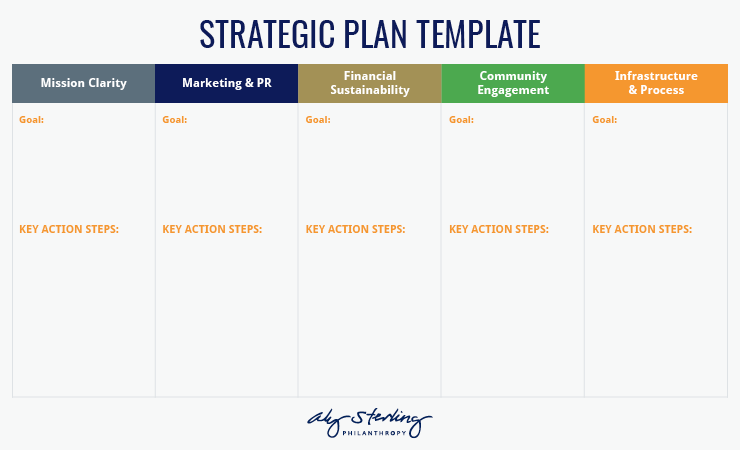
Next, break down each pillar into its own chart to pinpoint specific actions and tasks associated with every priority:
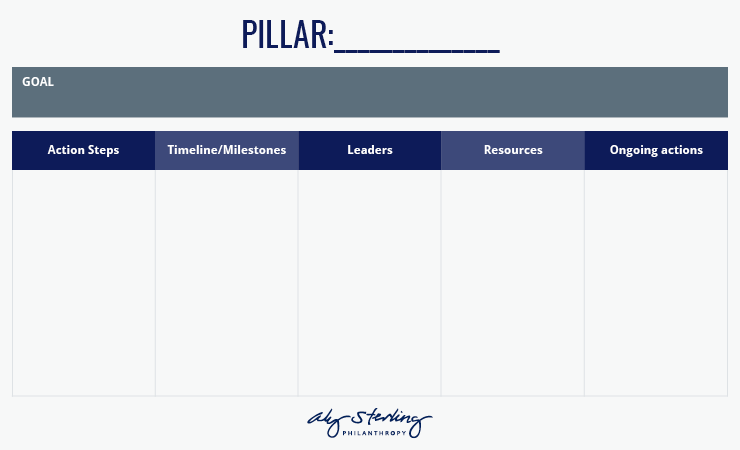
For each priority, determine the associated action steps, timeline/milestones, leaders, necessary resources and future/ongoing actions:
These documents will provide a tangible resource your team can turn to for guidance as they carry out your nonprofit strategic plan. Fill out these templates using your organization’s top priorities and tasks associated with each step.
While your nonprofit strategic plan should be unique to your organization, it’s helpful to draw inspiration from other organizations to guide your approach. See what’s possible for your nonprofit by exploring this list of top nonprofit strategic plans.
The Boys and Girls Club of America is dedicated to creating brighter futures for young people across the country. As a national organization with an ambitious mission, it was essential for the Boys and Girls Club of America to craft a comprehensive strategic plan that unites their Club partners and families around their vision for the future.

In their nonprofit strategic plan titled “Great Futures 2025,” the Boys and Girls Club outlines four strategic priorities that will help them cultivate young leaders:
To reach these goals, this nonprofit has outlined specific initiatives they’ll lead, such as improving program effectiveness through establishing quality standards, increasing government funding for youth development and building strong partnerships with schools. This level of specificity gives the Boys and Girls Club a clear framework to achieve its goals over the next few years.
The Legal Aid Foundation of Los Angeles seeks equal justice for impoverished individuals in the greater Los Angeles area. To bring this mission to fruition, the Legal Aid Foundation created a dynamic strategic framework that addresses the specific actions they’ll take over the following five years.
Their plan lays out the following seven strategic priorities:
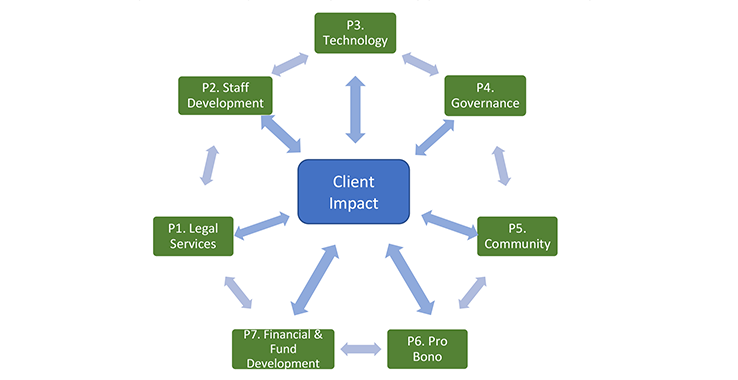
Not only does this organization detail what their priorities are, but they also identify the staff leads, the specific goals and the metrics that will be used to measure success for each priority. Plus, the Legal Aid Foundation explains how each strategic priority connects back to its cause and founding principles, grounding its plan in its mission.
The Ronald McDonald House Charities of Northwest Ohio aims to enrich the lives of sick children and their families by providing housing, resources, educational programs and more. This charity created a nonprofit strategic plan for 2022-2025 to become a leader in access to healthcare for children.
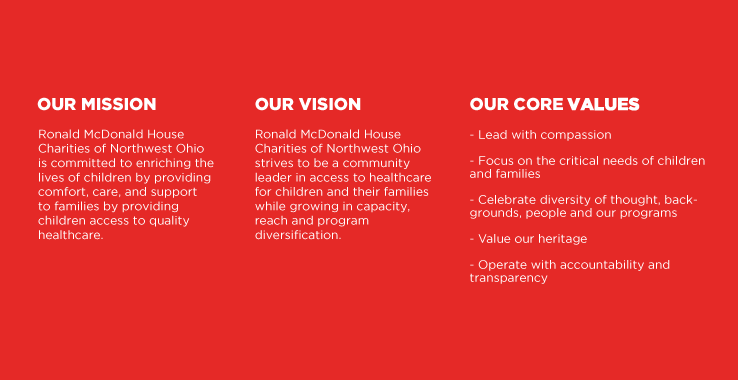
Their plan is organized around strategic initiatives like building capacity to support the programmatic needs of the community and identifying and implementing opportunities to enhance quality healthcare access. With these guiding priorities in place, the Ronald McDonald House Charities of Northwest Ohio can effectively put their dreams into action.
Goodwill Industries of Northwest Ohio is devoted to eliminating barriers to work and providing opportunities for people to reach their full potential. Guided by their philosophy of the “power of work,” Goodwill needed a nonprofit strategic plan to help community members live independently, earn a fair living wage and meet their personal goals.
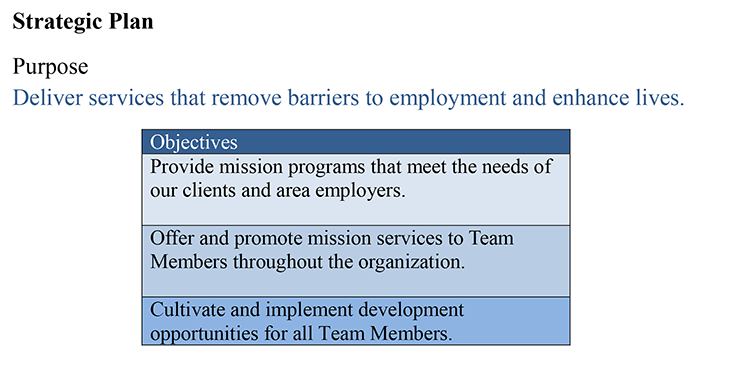
Their 2022-2024 strategic plan begins by outlining their vision and values, including integrity, passion and respect. Next, the plan identifies specific objectives to transform lives in their community, organized into categories like financial sustainability and community. This guide is a great reference point for their staff and ensures everyone is on the same page.
Metroparks Toledo is a park district committed to conserving the region’s resources through the management of natural parks and open spaces. As explained in the introduction of their nonprofit strategic plan, Metroparks hopes to not only improve outdoor spaces for the enjoyment of the public but also cultivate high performance and satisfaction among park employees.

In their strategic plan, Metroparks kicks off with an overview of who they are, their mission and their vision for the future. Then, they break down the following strategic priorities:
Following the Aly Sterling Philanthropy strategic planning model, Metroparks outlines a plan of action for each of these priorities, including key objectives and key performance indicators to measure their progress. This helps Metroparks’ community members and employees understand the actions this organization will take to advance their mission.
The Alzheimer’s Association seeks to end Alzheimer’s and other forms of dementia by conducting global research, driving risk reduction and early detection and improving access to quality care. This organization released a 2023-2025 strategic plan to accelerate its mission and change the trajectory of Alzheimer’s for millions of people.

The Alzheimer’s Association builds a strong case for support in their strategic plan by identifying relevant statistics, like the rising costs associated with Alzheimer’s in the nation, which is projected to be more than $1.1 trillion in 2050. They then cover their strategic priorities, including advancing public policy, increasing revenue and boosting awareness.
To establish a clear framework for their projected progress, the Alzheimer’s Association outlines strategic, measurable objectives. For instance, they explain that they’ll accelerate research by providing more funding opportunities, aiming to invest $110 million by the end of 2025. This specificity provides their entire team with the clarity necessary to complete their responsibilities and contribute to the Alzheimer’s Association’s success.
The Bryan Area Foundation is a community foundation that strives to improve the lives of individuals living in Williams County, Ohio. One of their central projects is providing millions of dollars to worthy community projects and scholarships. To continue this charitable giving (along with other initiatives), the Bryan Area Foundation needed a nonprofit strategic plan that outlined how to make this possible.
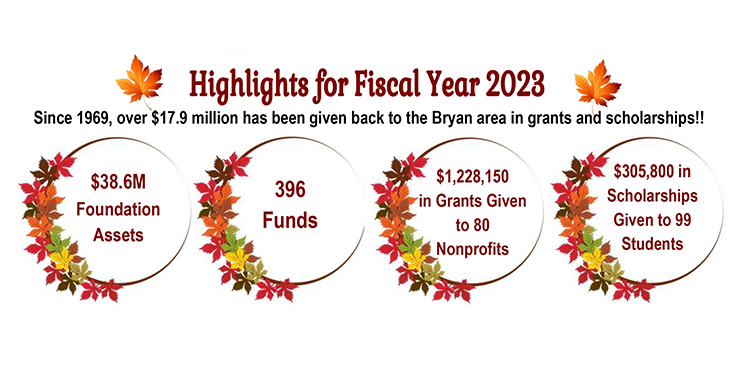
In their 2021 to 2023 strategic plan, the Bryan Center Foundation identified new projects to complete, including a revitalization of downtown Bryan to grow the number and quality of businesses. Since launching this plan, the Bryan Center Foundation has created a Community Impact Project and Forgivable Loan Program, supporting their commitment to “Building for the future.”
The DeKalb County Community Foundation’s mission is to benefit organizations and communities throughout DeKalb County, Illinois. In its nonprofit strategic plan for 2022-2024, this foundation outlines how it intends to create change by addressing the following four key areas: Endowments and Donor Services, Stewardship, Grantmaking and Community Initiatives.
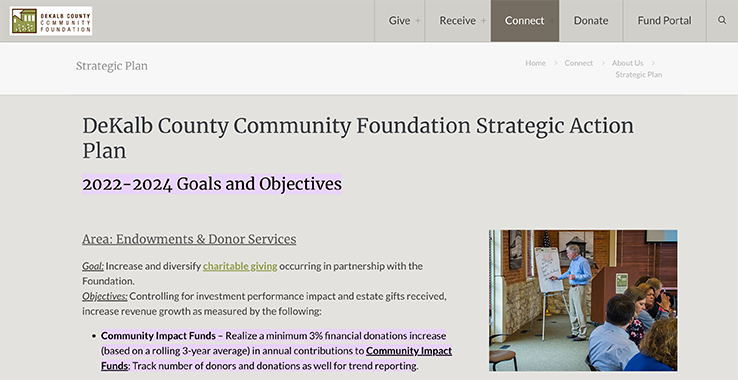
DeKalb County Community Foundation’s goals and objectives are precise, with measurable objectives like realizing a minimum 3% financial donations increase in annual contributions to Community Impact Funds. Specific, measurable goals give this foundation the direction it needs to maximize its success and foster accountability across its team.
The World Wildlife Fund (WWF) of Colombia aims to set Colombia on a path to sustainable, low carbon and resilient development. WWF created a nonprofit strategic plan for 2020-2025 to address its ambitious goal of making the country a better place for people and wildlife.

The organization’s strategic plan is centered around three main priorities:
WWF not only addresses Colombia’s strategies and goals in its strategic plan document but also global targets to improve people’s and animals’ lives worldwide. This helps to connect WWF Colombia to the core principles and mission that define WWF as a whole.
Big Brothers Big Sisters of Central Mass & Metrowest (BBBSCM) was established to create professionally supported mentoring relationships and build brighter futures for today’s youth. In their nonprofit strategic plan for 2020-2023, BBBSCM detailed its mission, vision, values and beliefs, making it a great resource for supporters getting to know their organization and for staff and volunteers to reference in their work.
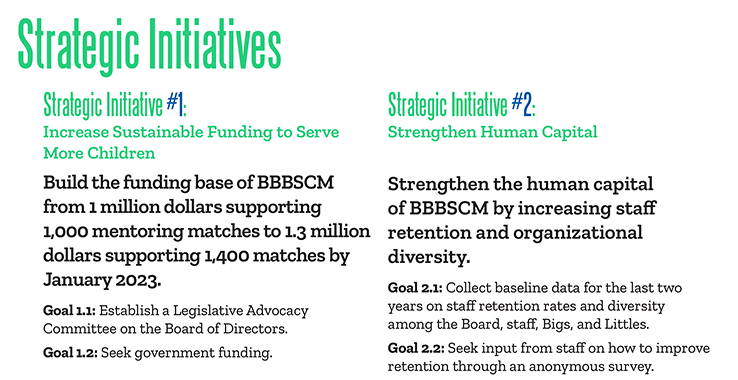
Then, this organization established its top four priorities and associated objectives, such as increasing sustainable funding by identifying new major donor prospects, with the goal of adding three to five major donors per year. BBBSCM also identified its strengths, challenges, threats and opportunities and tailored its strategic plan to these elements.
As a result, BBBSCM demonstrates in its strategic plan document that its team is committed to seeing its mission through and will take the necessary steps to create its vision for the future.
The time, energy and funding you spend on nonprofit strategic planning is an investment in your organization’s future. Don’t let that investment go to waste; instead, strive to carry out your organization’s strategic plan to the fullest.
Here are some of our top tips for keeping your strategic plan alive:
With these tips, you can maintain the initial excitement and momentum built during your strategic planning process. This will ensure your plan is doing what it was meant to—furthering your organization’s mission effectively.
The right nonprofit consultant will walk you through every step of the nonprofit strategic planning process. By tapping into their years of expertise, they’ll help you craft a dynamic framework to improve your organization’s financial health, effectiveness, capacity and relevance within your community.
Your consultant will support your strategic planning by:
In addition to these core services, your consultant can also help you:
Do your research to find the right consulting firm that will thoughtfully and objectively consider your nonprofit’s current state and work with you to create a pathway to success. When you partner with the expert consultants at Aly Sterling Philanthropy, you can get an unbiased look at your organization and receive realistic guidance to construct your strategic plan.
When it comes to making your mission a reality and following through on your promises, don’t just wing it! A nonprofit strategic plan gives you the necessary framework to confidently tackle your goals, unify your team and leave a lasting impact on your community.
While taking an in-house approach to strategic planning is possible, it can be challenging to build a cohesive, objective plan from the inside. Contact us for help creating a comprehensive strategic plan that empowers you to achieve your goals.
For more information on nonprofit strategic planning, check out the following resources: